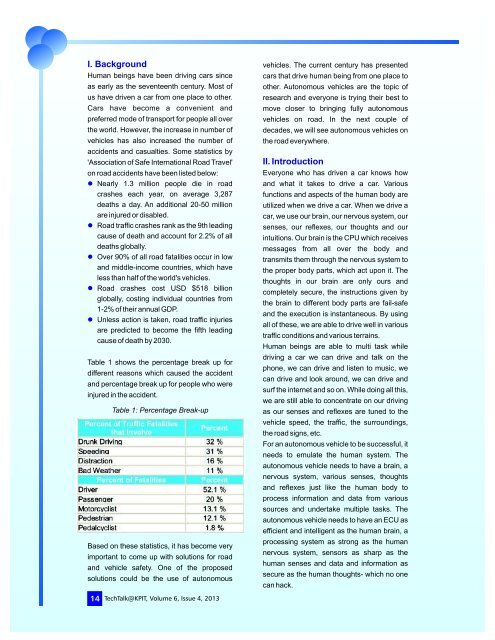Autonomous Vehicles - KPIT
Autonomous Vehicles - KPIT
Autonomous Vehicles - KPIT
Create successful ePaper yourself
Turn your PDF publications into a flip-book with our unique Google optimized e-Paper software.
I. Background<br />
Human beings have been driving cars since<br />
as early as the seventeenth century. Most of<br />
us have driven a car from one place to other.<br />
Cars have become a convenient and<br />
preferred mode of transport for people all over<br />
the world. However, the increase in number of<br />
vehicles has also increased the number of<br />
accidents and casualties. Some statistics by<br />
'Association of Safe International Road Travel'<br />
on road accidents have been listed below:<br />
lNearly 1.3 million people die in road<br />
crashes each year, on average 3,287<br />
deaths a day. An additional 20-50 million<br />
are injured or disabled.<br />
lRoad traffic crashes rank as the 9th leading<br />
cause of death and account for 2.2% of all<br />
deaths globally.<br />
lOver 90% of all road fatalities occur in low<br />
and middle-income countries, which have<br />
less than half of the world's vehicles.<br />
lRoad crashes cost USD $518 billion<br />
globally, costing individual countries from<br />
1-2% of their annual GDP.<br />
lUnless action is taken, road traffic injuries<br />
are predicted to become the fifth leading<br />
cause of death by 2030.<br />
Table 1 shows the percentage break up for<br />
different reasons which caused the accident<br />
and percentage break up for people who were<br />
injured in the accident.<br />
Table 1: Percentage Break-up<br />
Based on these statistics, it has become very<br />
important to come up with solutions for road<br />
and vehicle safety. One of the proposed<br />
solutions could be the use of autonomous<br />
vehicles. The current century has presented<br />
cars that drive human being from one place to<br />
other. <strong>Autonomous</strong> vehicles are the topic of<br />
research and everyone is trying their best to<br />
move closer to bringing fully autonomous<br />
vehicles on road. In the next couple of<br />
decades, we will see autonomous vehicles on<br />
the road everywhere.<br />
II. Introduction<br />
Everyone who has driven a car knows how<br />
and what it takes to drive a car. Various<br />
functions and aspects of the human body are<br />
utilized when we drive a car. When we drive a<br />
car, we use our brain, our nervous system, our<br />
senses, our reflexes, our thoughts and our<br />
intuitions. Our brain is the CPU which receives<br />
messages from all over the body and<br />
transmits them through the nervous system to<br />
the proper body parts, which act upon it. The<br />
thoughts in our brain are only ours and<br />
completely secure, the instructions given by<br />
the brain to different body parts are fail-safe<br />
and the execution is instantaneous. By using<br />
all of these, we are able to drive well in various<br />
traffic conditions and various terrains.<br />
Human beings are able to multi task while<br />
driving a car we can drive and talk on the<br />
phone, we can drive and listen to music, we<br />
can drive and look around, we can drive and<br />
surf the internet and so on. While doing all this,<br />
we are still able to concentrate on our driving<br />
as our senses and reflexes are tuned to the<br />
vehicle speed, the traffic, the surroundings,<br />
the road signs, etc.<br />
For an autonomous vehicle to be successful, it<br />
needs to emulate the human system. The<br />
autonomous vehicle needs to have a brain, a<br />
nervous system, various senses, thoughts<br />
and reflexes just like the human body to<br />
process information and data from various<br />
sources and undertake multiple tasks. The<br />
autonomous vehicle needs to have an ECU as<br />
efficient and intelligent as the human brain, a<br />
processing system as strong as the human<br />
nervous system, sensors as sharp as the<br />
human senses and data and information as<br />
secure as the human thoughts- which no one<br />
can hack.<br />
14 TechTalk@<strong>KPIT</strong>, Volume 6, Issue 4, 2013


